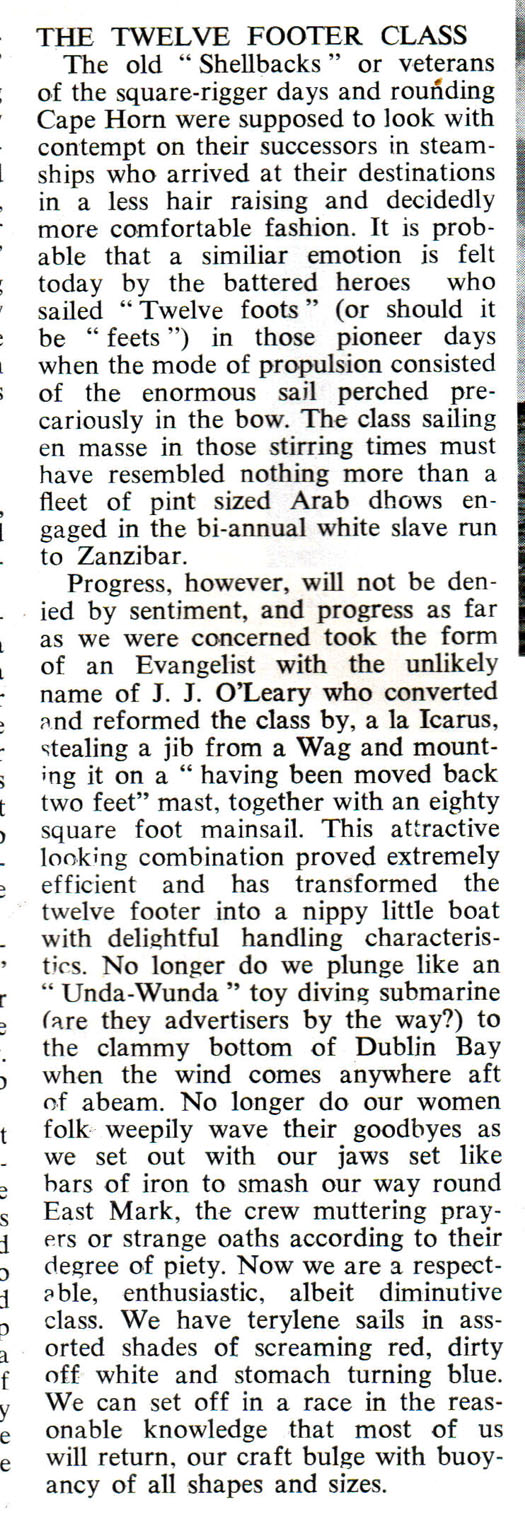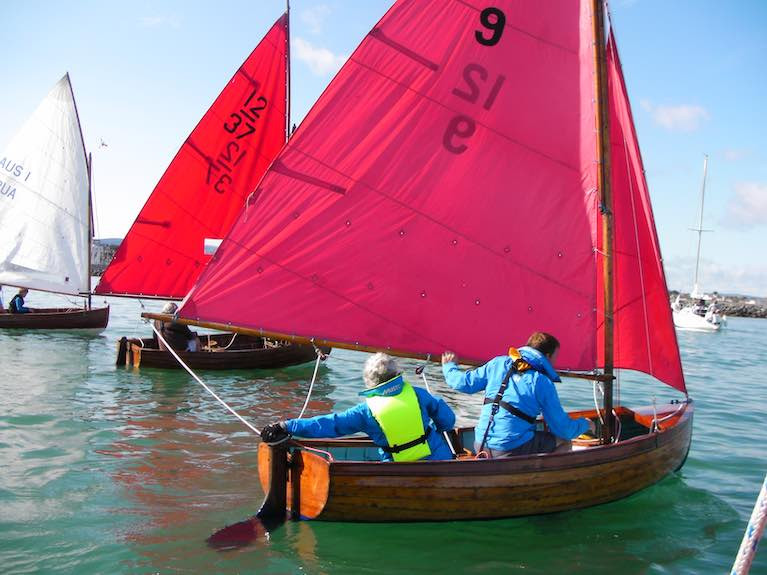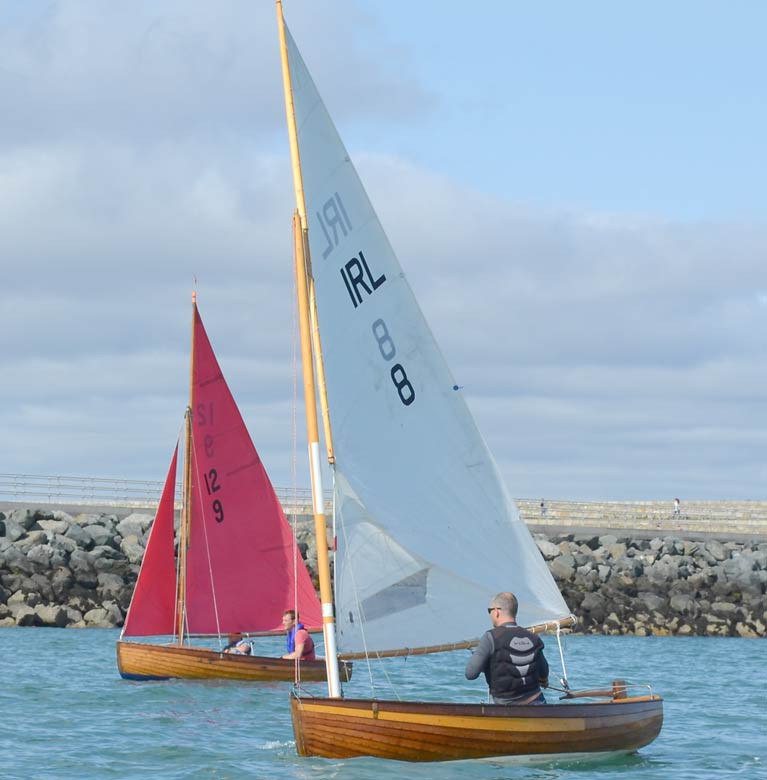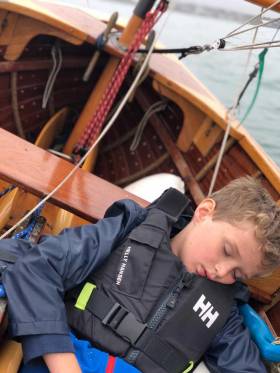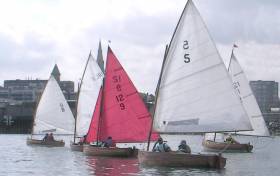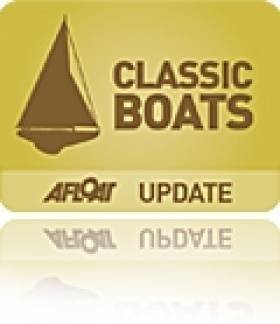Displaying items by tag: International 12
Varian & Johnson Win Royal St. George Yacht Club Hosted 10th Anniversary of Revived Irish 12-Foot Championship
The Royal St George Yacht Club in Dun Laoghaire hosted the 2020 Irish 12 Foot Dinghy Championships on 13th September with two alternative rigs permissible, the International 12 Foot Dinghy rig with a single sail and the Dublin Bay Sailing Club rig which permits the same sail area to be distributed between the mainsail and jib. This alternative rig was devised in the 1960s to address the steep waves of Dublin Bay.
The weather forecast seemed to suggest 8 knots of wind from the southwest with gusts of up to 18 knots. The 12 Foot Dinghy Association and OOD communicated with the competitors on the evening before the event asking them to bring reefing equipment with them, so that the event could proceed even if the weather was unkindly. The day dawned with a blue sky and a 2-4 knot wind with occasional gusts of 12 knots.
Race one started with a northeasterly wind and just after the start, it shifted to the north-west. Gavan Johnson in 'Albany' was quick to adapt to the new wind and after a shortened course signal reduced the race to one lap of the course, he won the race from young Andrew Miller in 'Pixie.'
 The fleet led by Ian Magowan in 'Sgadan'
The fleet led by Ian Magowan in 'Sgadan'
By race two, the wind had shifted to the south-west, but once again shifted to the south-east as Ian Magowan in 'Sgadan' led from 'Albany.' It was quite a battle between these two but 'Albany' had the speed and tactics to lead over the finish line.
The third race started in a delightful 6 knots of breeze from the northeast but just before the dinghies reached the windward mark the wind disappeared and the race was abandoned.
All sailed or paddled ashore for a hearty brunch with a nice pint of Guinness with the hope of better wind in the afternoon. Since all the wet Pubs throughout the country are closed- it is delightful to enjoy a pint with your brunch.
 David and Henry Shackleton in 'Scythian'
David and Henry Shackleton in 'Scythian'
In the afternoon the wind was initially from the south-west. Halfway up the beat the wind died and came back from the northeast. With one of the turning marks close to the marina breakwater, 'Cora' lost her momentum and when it looked like she could drift onto the rocky breakwater, crew Ruairi Shanahan pulled out an oar to push them off. Due to this illegal propulsion, they retired from this race which was again won by 'Albany.'
In the final race, the wind was back in the northeast, and Vincent Delany took the helm of 'Cora,' but he couldn't touch 'Albany' for speed in the prevailing conditions.
Gail Varian and son-in-law Gavan Johnson won the historic Edmond Johnston Trophy and the Altair Trophy for the crew of the winning boat and Andrew Miller and Iseult Costello who shared the steering of 'Pixie' won the historic Cora Trophy.
 Andrew Miller winner of the Irish International 12 Foot Dinghy Championship in 'Pixie'
Andrew Miller winner of the Irish International 12 Foot Dinghy Championship in 'Pixie'
Download final results below as an Xcel file.
Next year the 12-foot dinghies move to Lough Ree Yacht Club for their Irish championship.
This class was designed in 1913 by George Cockshott as the British Racing Association ‘A’ Class. The class was adopted by the International Yacht Racing Union on 1st. January 1920 and thus it became the International 12 Foot Class. The class was the only dinghy class to compete at the 1920 Antwerp (Belgium) Olympic Games, at Oostende.
Unfortunately due to COVID 19 the Olympic centenary regatta at Oostende was postponed.
As Afloat previously reported, the class grew in popularity in Ireland in the 1920s and 1930s with fleets of professionally and amateur-built boats in Baltimore, Crosshaven, Howth, Sutton, Malahide, Clontarf and Seapoint (Monkstown, Co. Dublin).
Today many 12 Foot Dinghies still exist in Ireland, having been in the same families for many years. Some are unused and located in barns while others are used as yacht tenders. In 2010, Gail Varian organised a revived Irish championship at the Royal St George Yacht Club.
The 10th anniversary of this revived championship for historic prizes will be held at the Royal St George Yacht Club, Dun Laoghaire Harbour on Sunday 13th September in which the modified Dublin Bay 12 foot dinghies with a mainsail and jib will sail against the International 12 foot Dinghies with just a mainsail on equal terms.
The organisers would like to hear from any Irish owners of 12 Footers.
For more information contact [email protected]
Quick Nap for Henry in the International 12-foot Dinghy Championships
In any sailing event, the helmsman must concentrate on his sails, and on the motion of the vessel through the water. Most crews really don’t have much to do except when the boat arrives at the corners on the course writes Vincent Delany
At the International 12-foot Dinghy Championship at the Royal St George Yacht Club, Dun Laoghaire on 15th September, young Henry Shackleton knowing that he had nothing to do until he heard the words ‘Ready about’ from his dad, David, took the opportunity of a quick nap after a hard night on the town. Despite, Henry napping, he finished in second place in the competition for the historic Altair Cup originally won by Billy Mooney.
We look forward to Henry competing as a helmsman in the Irish 12 Foot Dinghy Championship in ten year’s time in his grandfather’s 12-foot dinghy which is due for restoration in the near future.
 Aus 1 and others
Aus 1 and others
The third annual event in recent years, representing the revival of Ireland's first international class of dinghy, the International 12 and DBSC 12, will be held at the Royal St. George Yacht Club on September 10th 2017.
Designed in 1912–despite appearing to be relatively slow or old fashioned, the class is organised by a very enthusiastic group of boat owners.
Large fleets were once located in Baltimore, Cork Harbour, Howth, Sutton, Dublin Bay and other Irish sailing venues.
'We are still trying to find the boats which might be hiding in sheds and garages around the country', says class activist, the RStGYC–based, Vincent Delany.
#international12 – Classic boat sailors in Dun Laoghaire are intending to hold a championship for the vintage 12–footers in the Royal St George Yacht Club on 30th August.
The purpose in holding the event this year is as a preview of a friendship regatta for visitors from Holland, Italy, Turkey and Japan in 2017 as part of the Volvo Dun Laoghaire Regatta.
If you have any contact details for any current owners, please contact the sailing manager in the RStGYC as soon as possible.
Five weeks advance notice has been given to allow owners to have their boats in tip-top condition for the event. The Notice of Race is downloadable below.
More on the International 12 class here
#international12 – Ireland will be at the forefront of centenary dinghy celebrations to be held in the UK next week in an historic class still active in Ireland.
The 1913 designed international 12–foot dinghy is having a centenary regatta on a marine lake at West Kirby, near Liverpool from the 28th to 30th of June.
30 boats from six countries are competing including three Irish boats sailed by Aiden Henry, Billy Bebbington, Margret Delaney, Gerry Murray, and George Miller.
'A practical dinghy, good to row, easy to sail (though difficult to sail well), very capable as a tender, it is, all in all, the perfect all round dinghy', say enthusiasts.
The 12s held an Irish national Championship at the Royal St. George YC in 2011 and a look back through Irish sailing archives reveals strong ties to many Irish Yacht Clubs (See images below).
At that championship boats sailed with the original International 12 foot rig – with no foredeck, no jib, and with a dipping lug rig – and with the Dublin Bay rig of a small foredeck with washboards, jaws on the bottom of the gaff and a small jib.
The Delany family boat 'Cora' No. 8 will be attending West Kirby. Steered by Margaret Delany who is currently based in the UK, but, as the boat has an Irish sail number, she will be classified as an Irish boat.
Cora has undergone substantial rebuilding at Norfolk Boatbuilding School. She has returned to the original rig and has been receiving advice from the International 12 foot sailors from Holland.
George Miller from the Royal St. George Yacht Club has attended several Intrernational 12 regattas in Italy and elsewhere in recent years.

The boats were originally called the British Racing Association 12–footer and were later awarded Olympic status. They were also awarded international status about the same time.
There are currently strong fleets in Turkey, Japan, Holland, Italy and smaller fleets in the UK and some other countries.
Irish fleets were orignally strongest in Royal Munster Yacht Club (documented in RCYC's history), Seapoint Sailing Club, Sutton Dinghy Club, Howth Sailing Club and Clontarf Yacht and Boat Club.
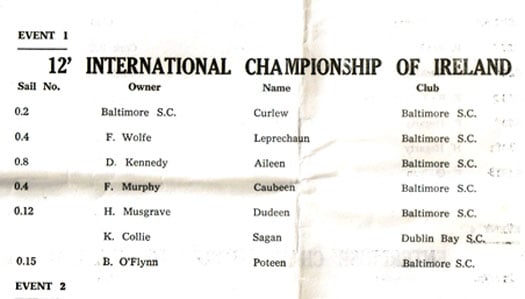
An entry list of the Irish Int 12 foot championship at IDRA Dinghy Week in Baltimore, West Cork year 1960 or 1964
A former Olympic class in 1920 and 1928, it became relatively obscure outside Holland, Italy, and Japan.
Although superseded by modern dinghies there has been a revival with new boats being built.
Below is a contemporary text from the foreunner to Afloat magazine describing how the 12s evolved.
